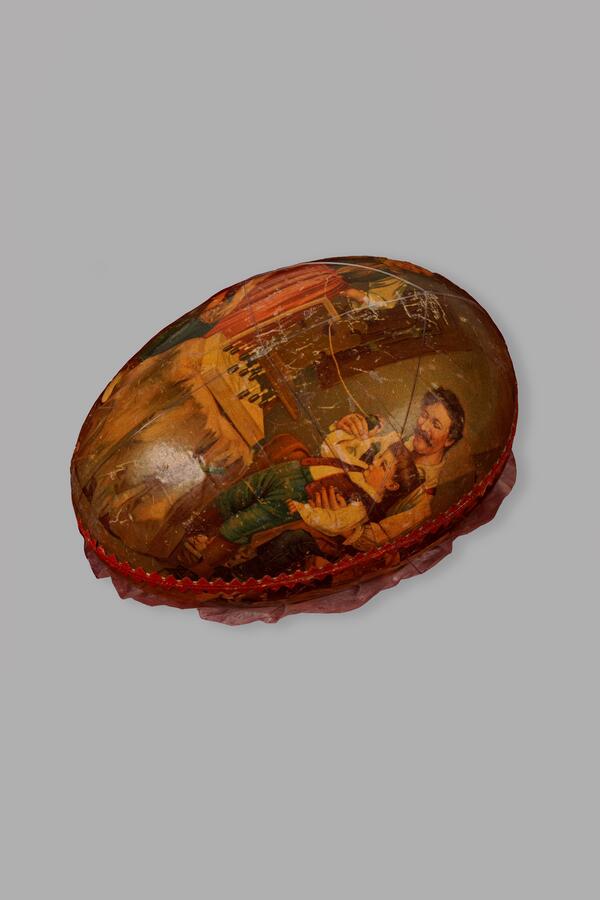Easter is considered to be the greatest holiday in Christian culture. There are many customs associated with this festival that are rooted in the distant past. One of them is the Easter Acclamation — a special greeting on the first day of Easter and during the next forty days until the last day of an Afterfeast. During the Easter greetings, people usually exchange colored eggs.
Traditionally, Easter eggs were dyed red. Later they could be dyed pink, green, blue or yellow, decorated with Christian symbols, patterns, drawings, and even brief didactic inscriptions. Over time, this pastime had become a kind of real art, and artisans started using durable materials to create eggs.
During the reign of Aleksey Mikhaylovich, about 30,000 eggs were prepared each Easter to be given as a gift. These were both edible and souvenir eggs — the latter were made of bone or wood, painted or carved. In the 17th century, the herbalist of the the Trinity Lavra of St. Sergius Prokopy Ivanov, the icon painters Bogdan Saltanov, Vasily Kuzmin and Nikifor Bavykin, the heirs of the iconographer of the Armory, brothers Aleksey and Ivan Zubov, created souvenir eggs for the tsar.
In the 18th and 19th centuries, people of different social backgrounds were keen on decorating Easter eggs. Peasants usually exchanged traditional one-color krashenkas or patterned wooden pisankas. Easter souvenirs that were made of precious materials were more exquisite, and their design followed the frequent changes of fashion. They were made throughout the country by artisans and manufacturers, and often painted in icon-painting workshops. On the eve of Easter, the Saint Petersburg confectioneries sold egg boxes, egg pendants, empty and with a surprise, made of wood, glass, cardboard, papier-mâché or porcelain.
The first porcelain egg was made by Dmitry Vinogradov, the inventor of Russian porcelain. From that time until the revolution in 1917, the Imperial Porcelain Factory produced a batch of such eggs every year, including the eggs for the imperial family “for giving away.” It was not the traditional religious, but the artistic value of the products that came to the fore: porcelain eggs, for example, could feature the image of cupids.
The products made by the firm of Carl Fabergé won particular renown. The company was commissioned to create luxurious Easter eggs for the emperors Alexander III and Nicholas II, and for Prince Felix Yusupov. In addition to decorations, some eggs had a winding mechanism. These products were highly valued and were taken out of safes and cases to be displayed only on the days of Easter celebrations.
Traditionally, Easter eggs were dyed red. Later they could be dyed pink, green, blue or yellow, decorated with Christian symbols, patterns, drawings, and even brief didactic inscriptions. Over time, this pastime had become a kind of real art, and artisans started using durable materials to create eggs.
During the reign of Aleksey Mikhaylovich, about 30,000 eggs were prepared each Easter to be given as a gift. These were both edible and souvenir eggs — the latter were made of bone or wood, painted or carved. In the 17th century, the herbalist of the the Trinity Lavra of St. Sergius Prokopy Ivanov, the icon painters Bogdan Saltanov, Vasily Kuzmin and Nikifor Bavykin, the heirs of the iconographer of the Armory, brothers Aleksey and Ivan Zubov, created souvenir eggs for the tsar.
In the 18th and 19th centuries, people of different social backgrounds were keen on decorating Easter eggs. Peasants usually exchanged traditional one-color krashenkas or patterned wooden pisankas. Easter souvenirs that were made of precious materials were more exquisite, and their design followed the frequent changes of fashion. They were made throughout the country by artisans and manufacturers, and often painted in icon-painting workshops. On the eve of Easter, the Saint Petersburg confectioneries sold egg boxes, egg pendants, empty and with a surprise, made of wood, glass, cardboard, papier-mâché or porcelain.
The first porcelain egg was made by Dmitry Vinogradov, the inventor of Russian porcelain. From that time until the revolution in 1917, the Imperial Porcelain Factory produced a batch of such eggs every year, including the eggs for the imperial family “for giving away.” It was not the traditional religious, but the artistic value of the products that came to the fore: porcelain eggs, for example, could feature the image of cupids.
The products made by the firm of Carl Fabergé won particular renown. The company was commissioned to create luxurious Easter eggs for the emperors Alexander III and Nicholas II, and for Prince Felix Yusupov. In addition to decorations, some eggs had a winding mechanism. These products were highly valued and were taken out of safes and cases to be displayed only on the days of Easter celebrations.





